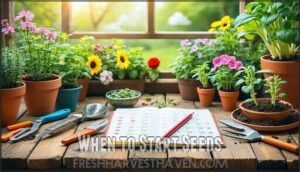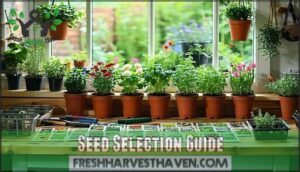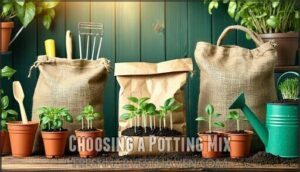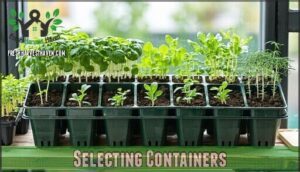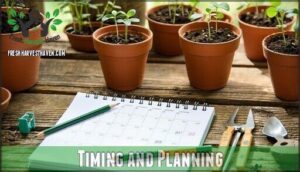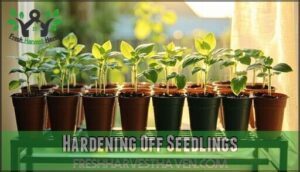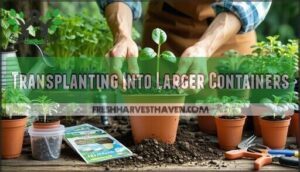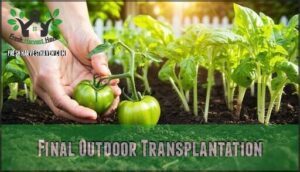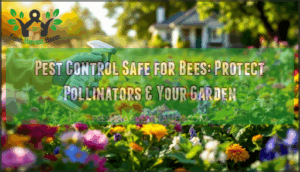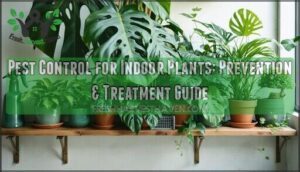This site is supported by our readers. We may earn a commission, at no cost to you, if you purchase through links.
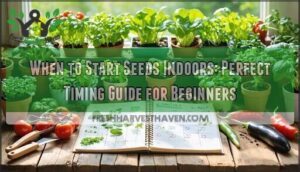 You’ll want to start seeds indoors 4-12 weeks before your last frost date, depending on what you’re growing.
You’ll want to start seeds indoors 4-12 weeks before your last frost date, depending on what you’re growing.
Cool-season crops like lettuce need just 4-6 weeks, while heat-loving tomatoes require 6-8 weeks to develop strong stems.
Peppers and eggplants need even more time—up to 10-12 weeks.
The key is timing transplant-ready seedlings with safe outdoor conditions.
Start too early and you’ll get leggy, root-bound plants; too late and they won’t establish before harsh weather hits.
Your local frost date is your North Star for planning, but each crop has its own sweet spot for ideal growth and transplant success.
Table Of Contents
- Key Takeaways
- Starting Seeds Indoors
- When to Start Seeds
- Seed Selection Guide
- Preparing for Indoor Sowing
- Timing and Planning
- Transplanting Seedlings
- Frequently Asked Questions (FAQs)
- How to plant seeds indoors?
- What are different ways to start seeds indoors?
- When should I start seeds indoors for cool weather crops?
- What herbs can you grow indoors?
- What month should you start seeds indoors?
- What happens if you start seeds indoors too early?
- Is March too early to start seeds?
- Is April too late to start seeds indoors?
- What supplies do I need for starting seeds?
- How do I prevent seedlings from getting leggy?
- Conclusion
Key Takeaways
- Time your seed starting based on your last frost date – Count backwards 4-12 weeks, depending on the crop, with cool-season vegetables like lettuce needing 4-6 weeks and heat-loving plants like peppers requiring 10-12 weeks indoors.
- You’ll extend your growing season by 6-8 weeks – Starting seeds indoors gives you healthier plants, access to more varieties, and higher germination rates compared to direct sowing outdoors.
- Soil temperature matters more than air temperature – Cool-season crops germinate at 45-65°F, while warm-season crops need 70-80°F soil temperatures for successful sprouting.
- Don’t start too early or you’ll create problems – Seeds started before 10+ hours of daily light become weak and leggy, while starting too late won’t give plants enough time to establish before harsh weather hits.
Starting Seeds Indoors
Starting seeds indoors gives you a head start on the growing season and lets you control growing conditions from day one.
You’ll get healthier plants, access to more varieties, and can extend your harvest window by 4-8 weeks compared to direct sowing, which allows for a longer growing season.
Benefits of Indoor Seed Starting
Starting seeds indoors gives you the Indoor Advantage of controlling every factor affecting germination.
You’ll achieve Early Harvest by gaining 6-8 weeks on the growing season, while Seed Control guarantees Healthy Starts free from pests and diseases.
Indoor seed starting delivers Fruitful Yields through higher germination rates and stronger seedlings that outperform direct-sown plants consistently.
By utilizing indoor seed starting, gardeners can experience the benefits of extended growing seasons and increased crop diversity.
Choosing The Right Seeds
Your seed selection determines your garden’s success before you even plant.
Choose varieties suited to your specific climate zone and frost tolerance requirements.
Research seed varieties from reliable seed sources, checking their germination rates and climate suitability.
Some plants thrive in cool weather while others need heat.
Quality seeds from reputable suppliers guarantee better germination rates and healthier starts for your indoor seed starting journey.
Understanding Climate and Region
Your region’s climate zones and frost dates serve as your garden’s GPS coordinates.
Check USDA hardiness zones to identify your planting zone—Zone 5 gardeners face last frost dates around May 15th, while Zone 9 enjoys frost-free dates by early March.
Regional planning requires understanding local weather patterns and geographic variations that affect your specific microclimate.
When to Start Seeds
Perfect timing makes the difference between thriving seedlings and disappointing failures. Your seed starting schedule depends on several key factors that work together like pieces of a puzzle.
Frost dates serve as your North Star for seed timing. Count backwards from your area’s average last frost date—typically found through your local extension office or USDA climate zones. Most seeds need 6-8 weeks indoors, but this varies dramatically by plant type.
Soil temperature trumps air temperature for germination rates. Cool-season crops like lettuce tolerate 45-65°F, while warm-season tomatoes demand 70-80°F. Starting too early in cold soil wastes seeds and delays growth.
Your seed starting calendar should account for daylight hours too. Seeds started before 10 hours of daily light often become weak and leggy, like teenagers who’ve grown too fast.
Climate zones guide your timing precision. Zone 5 gardeners typically start tomatoes mid-March for a May 15 transplant date, while Zone 8 can begin in February. When to sow seeds isn’t just about frost—it’s about creating ideal conditions for strong, healthy starts. Understanding the last frost dates is vital for determining the perfect seed starting time.
Seed Selection Guide
Choosing the right seeds determines your gardening success before you even plant. You’ll want to focus on varieties that thrive when started indoors and match your climate’s growing conditions.
Vegetables to Start Indoors
Choose vegetables that thrive with a head start.
Tomatoes, peppers, and eggplants need 6-8 weeks indoors before transplanting, while broccoli, cabbage, and cauliflower require 4-6 weeks.
These warm-season and cool-season crops benefit from controlled germination rates and ideal seed depth.
Your seed starting schedule should align with each variety’s specific indoor sowing requirements for successful vegetable timing.
To guarantee the best results, consider using proper grow lights to promote healthy seedling growth and ensure you have the right conditions for your plants to thrive with proper care.
Herbs to Start Indoors
Most herbs thrive when you’re starting seeds indoors, giving you fresh flavors year-round.
These aromatic powerhouses need specific timing for ideal seed germination and vigorous seedling care.
- Basil – Start 6-8 weeks before last frost; requires consistent warmth and herb lighting (14-16 hours daily)
- Indoor Parsley – Begin 6-10 weeks early; slow germination takes 2-4 weeks, benefits from pre-soaking
- Chives – Germinate in 10-14 days; frost-tolerant for early transplanting outdoors
- Oregano/Sage – Start in late winter; tiny seeds need light soil coverage and proper herb fertilizer
- Thyme/Rosemary – Perennial herbs requiring 65-75°F soil temperatures for best indoor gardening tips success
Flowers to Start Indoors
Starting flowers indoors opens up exciting possibilities beyond herbs. Many popular annuals like marigolds, zinnias, and cosmos thrive with indoor seed starting, achieving 90% germination success rates under controlled conditions.
You’ll enjoy earlier blooms and extended flowering seasons.
| Flower Type | Start Before Last Frost | Indoor Duration |
|---|---|---|
| Marigold | 6-8 weeks | Early March |
| Zinnia | 4-6 weeks | Mid March |
| Snapdragon | 6-8 weeks | Early March |
| Cosmos | 4-6 weeks | Mid March |
| Impatiens | 8-10 weeks | Late February |
Proper seed selection and indoor lighting create ideal conditions for flower seedlings, while quality soil guarantees healthy root development for successful blooming times ahead.
Understanding the correct last frost dates is vital for determining the ideal start time for various flower species.
Preparing for Indoor Sowing
Once you’ve selected your seeds, you’ll need to gather the right supplies to facilitate successful germination.
The three essential elements—quality potting mix, appropriate containers, and ideal growing conditions—will set your seedlings up for healthy development from day one, ensuring they have the best chance at thriving with complete care.
Choosing a Potting Mix
Your success with seed starting hinges on selecting the right potting mix. Quality matters more than price when you’re nurturing delicate seedlings.
Commercial seed starting mix offers superior drainage and sterile conditions, while organic options provide natural nutrition for developing roots.
- Seed starting mix – sterile, fine-textured blend designed for germination
- Peat moss base with perlite – improves drainage and prevents waterlogging
- Vermiculite addition – retains moisture while allowing air circulation
- Organic options include coconut coir mixed with compost for nutrient density
- Avoid garden soil – contains pathogens and creates poor drainage in containers
Using the right seed starting materials is vital for healthy seedling development.
Selecting Containers
Your container choice affects seedling success substantially. Container Size matters—cells should be 2-3 inches deep for proper root development.
Seed Trays with individual Cell Packs prevent root tangling, while Biodegradable Pots eliminate transplant shock since they decompose in soil.
| Container Type | Best For | Key Benefit |
|---|---|---|
| Seed Starting Trays | Multiple varieties | Space efficiency |
| Cell Packs | Individual plants | Root separation |
| Biodegradable Pots | Transplant-sensitive crops | Zero shock transfer |
| Recycled containers | Budget gardeners | Cost-effective option |
Drainage holes are non-negotiable—waterlogged seeds rot quickly. Clean containers prevent disease transmission between growing seasons.
Using proper seed tray systems is vital for healthy seedling growth.
Creating Optimal Growing Conditions
Once you’ve picked your containers, it’s time to create ideal conditions for seed starting indoors.
Think of seedlings as tiny athletes—they need the right training environment.
Focus on:
- Consistent soil temperature (65–75°F)
- Bright light exposure (grow lights or south windows)
- Careful water control—avoid soggy roots
- Stable humidity levels
- Gentle air circulation for sturdy seedling growth
To achieve the best results, understanding indoor grow lights is vital for providing the necessary bright light exposure and creating a suitable environment for sturdy seedling growth.
Timing and Planning
Timing your seed starting correctly means the difference between thriving seedlings and transplant shock disasters.
You’ll need to work backwards from your last frost date, accounting for each plant’s specific indoor growing requirements and transplant timeline.
Determining Last Frost Date
Your frost date acts like nature’s green light for transplanting.
The National Weather Service and local extension offices publish average last frost dates using 30-year climate data. Check NOAA’s NOWData or Farmer’s Almanac using your ZIP code for precise timing.
| USDA Zone | Average Last Frost | Example Locations |
|---|---|---|
| Zone 4 | May 15 | Northern Minnesota |
| Zone 6 | April 15 | Pennsylvania |
| Zone 10b | No frost | Southern California |
Remember that microclimates can shift dates by 10°F, so urban heat islands may experience earlier frost-free conditions than rural areas.
Scheduling Seed Starting
Carefully mapping your seed starting schedule transforms chaos into harvest success.
Start warm-season crops like tomatoes 6-8 weeks before your frost date, while cool-season vegetables begin 5-7 weeks prior.
Use climate zones and soil temperature data to fine-tune germination rates, ensuring your indoor seed starting techniques align perfectly with outdoor transplant readiness.
Avoiding Common Mistakes
Perfect timing beats perfect conditions every time.
Timing trumps technique—start right, succeed always.
New gardeners often rush or delay seed starting, creating unnecessary stress for both plants and themselves.
Here are three timing mistakes that’ll sabotage your indoor seed germination:
- Starting too early without proper light exposure – Seeds started before 10+ hours of daily light become weak and leggy, struggling with poor soil quality later
- Ignoring temperature control for seed depth requirements – Overwatering combined with incorrect soil temperatures kills more seeds than underwatering ever will
- Skipping hardening-off schedules – Rushing from indoor warmth to outdoor conditions shocks seedlings, regardless of perfect seed starting tips you’ve followed
Understanding common gardening mistakes is essential for a successful harvest.
Transplanting Seedlings
After weeks of careful nurturing, your seedlings are nearly ready for their big outdoor debut.
This pivotal phase determines whether your indoor growing efforts will result in thriving garden plants or stressed transplants that struggle to establish themselves.
Hardening Off Seedlings
Gradual seedling acclimation prevents transplant shock when shifting from indoor comfort to harsh outdoor conditions.
Start hardening off seven days before transplanting by placing seedlings outside for one hour in shade, gradually increasing exposure daily.
Weather protection becomes essential during wind or temperature drops below 50°F, and this outdoor acclimatization process strengthens stems and prepares leaves for UV intensity, ensuring successful outdoor shift and resilient seedling protection.
Transplanting Into Larger Containers
Transplant Timing becomes vital when seedlings outgrow their starting containers. This process, known as "potting up," prevents root binding and promotes healthy growth through proper Seedling Care techniques.
- Container Size matters: Choose pots 2-3 times larger than current containers to accommodate expanding root systems
- Potting Mix selection: Use sterile, well-draining mix specifically formulated for transplanting seedlings rather than garden soil
- Soil Preparation timing: Water seedlings lightly before transplanting to reduce transplant shock and ease removal
- Root inspection: Gently examine roots during transfer—healthy white roots indicate successful seedling acclimation
- Indoor seed starting tips: Handle seedlings by leaves, not stems, to prevent damage during the seedling transplant process
Final Outdoor Transplantation
After successful hardening off, you’ll choose the perfect transplant timing based on soil temperature and weather conditions.
Your seedlings are ready for their permanent home when nighttime temperatures consistently stay above their tolerance threshold.
| Plant Type | Soil Temperature | Timing After Last Frost |
|---|---|---|
| Cool-season crops | 45-50°F | 2-4 weeks before |
| Warm-season crops | 60-65°F | 1-2 weeks after |
| Heat-loving plants | 70°F+ | 2-3 weeks after |
Garden placement matters—choose locations with appropriate sun exposure and wind protection.
Proper soil prep guarantees strong root establishment, while continued seedling care during the first week helps plants adapt to their new environment without transplant shock.
Frequently Asked Questions (FAQs)
How to plant seeds indoors?
Starting seeds indoors transforms tiny specks into garden gold! Choose quality containers with drainage holes, fill with seed-starting mix, plant at proper depth, maintain consistent moisture, and provide adequate light.
What are different ways to start seeds indoors?
You can start seeds using seed trays, peat pots, recycled containers like yogurt cups, or biodegradable pellets that expand with water, each offering different transplanting advantages.
When should I start seeds indoors for cool weather crops?
Cool-season crops tolerate transplant shock 20-30% better than warm-season varieties.
You’ll want to start lettuce, spinach, and brassicas like broccoli 4-8 weeks before your last frost date, giving them time to develop strong roots.
What herbs can you grow indoors?
You’ll have great success growing basil, parsley, cilantro, chives, oregano, thyme, sage, and rosemary indoors. These herbs thrive in containers with adequate light and proper drainage.
What month should you start seeds indoors?
February’s frosty finale signals your seed-starting season. Begin cool-season crops like broccoli and lettuce 6-8 weeks before your last expected frost date, while warm-season vegetables need 6-10 weeks lead time.
What happens if you start seeds indoors too early?
Starting too early creates leggy, weak seedlings that struggle outdoors. You’ll face transplant shock, poor root development, and potential frost damage if planted prematurely before soil warms adequately.
Is March too early to start seeds?
March may manifest marvelous results, but timing depends on your frost-free date and crop choice.
Start cool-season vegetables like broccoli 6-8 weeks before last frost.
Wait until April for warm-season crops like tomatoes.
Is April too late to start seeds indoors?
April isn’t too late for many crops! You can still start warm-season vegetables like tomatoes, peppers, and herbs. Cool-season crops might be pushing it, but quick-growing varieties work fine.
What supplies do I need for starting seeds?
Ready to plant your future harvest? You’ll need containers with drainage holes, quality seed-starting mix, grow lights or sunny windowsill, labels, watering supplies, and heat mats for ideal germination success.
How do I prevent seedlings from getting leggy?
Provide bright light 12-14 hours daily using grow lights positioned 2-3 inches above seedlings. Rotate containers regularly for even growth. Keep consistent temperatures and avoid overwatering, which weakens stems.
Conclusion
Mastering when to start seeds indoors transforms you from a hopeful gardener into a harvest hero.
You’ve learned that timing isn’t just about avoiding frost—it’s about synchronizing your seedlings’ development with ideal transplant conditions.
Cool-season crops need 4-6 weeks, while heat-lovers require 6-12 weeks of indoor nurturing.
Your local frost date serves as the foundation, but each plant’s unique requirements determine success.
With proper planning, quality seeds, and patience, you’ll cultivate strong, transplant-ready seedlings that thrive outdoors.
- https://gardenplanner.almanac.com/
- https://garden.org/apps/frost-dates/
- https://monroecountymga.org/2020/04/22/what-seeds-can-germinate-in-cool-garden-soil/
- https://rootsandrefuge.com/planting-seedlings-indoors-advantages/
- https://seedsnsuch.com/blogs/gardeners-greenroom/direct-sow-or-start-seeds-indoors-the-difference-between-indoor-and-outdoor-seeds

